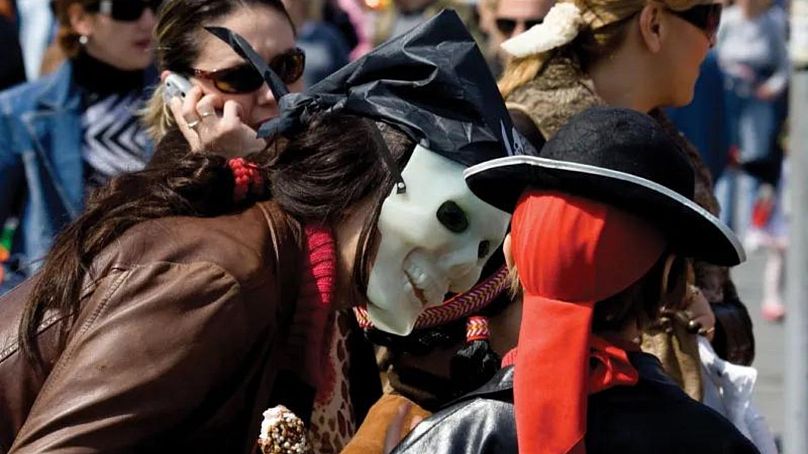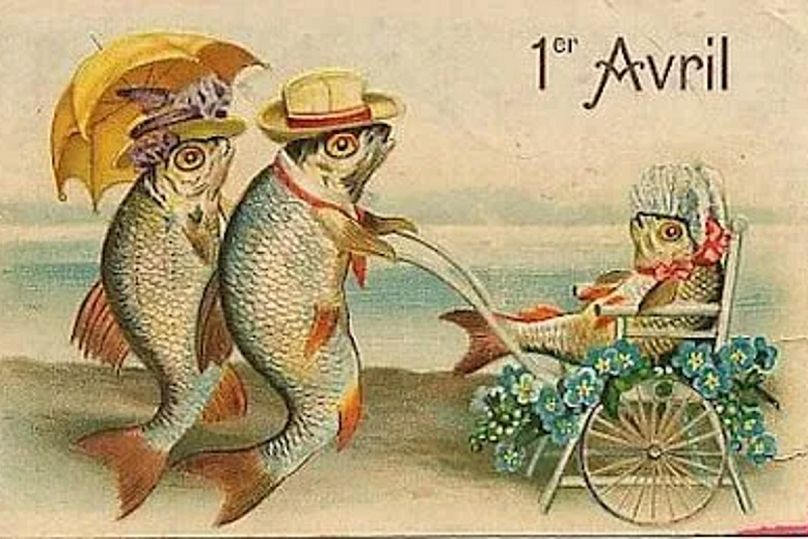April Fools' Day: Why do we collectively try to mess with others on 1 April, and how do different countries celebrate this festival of foolishness?
Happy April Fools' Day - also called All Fools’ Day - which is celebrated by many countries every year on 1 April.
Known for giving people a free pass to prank their partners, friends, family members and colleagues, the day seen as an opportunity to dupe the most gullible into believing the most outlandish things.
So, prank-lovers rejoice, and those averse to silliness… Well, suck it up.
But what are the origins of this day, and how do European countries celebrate this festival of foolishness?
Here's everything you need to know:
What is April Fools’ Day?
The day consists of practical jokes, pranks and hoaxes. Pranksters often yell “April Fools!” at their victim, and this custom has been observed for hundreds of years.
Where does it come from?
The origin of April Fools’ Day is debated.
Many trace the custom back to medieval France where 25 March used to be New Year's Day until the Julian calendar was reformed in 1564 and changed to the Gregorian calendar. Before then, New Year festivities culminated on 1 April. After 1 January was officially adopted as New Year's Day, those who forgot to change the date and continued to celebrate on 1 April were ridiculed and labelled April Fools.
Historians have linked April Fools’ Day to spring festivals such as the medieval Feast of Fools, wherein a Lord of Misrule was elected to parody Christian rituals, and Hilaria (Latin for 'joyful'), which was celebrated in ancient Rome at the end of March by followers of Phrygian goddess Cybele and her devotee Attis. Festivities included games, people dressing up in disguises and mocking their neighbours. It was the opportunity for disguised commoners to imitate nobility to devious ends without any repercussions.
Others have pointed out that the Holi festival in India, which also takes place in March, could be the source of the day. Known as the Festival of Colours, the annual occasion is meant to honour the arrival of spring and the Hindu god Krishna through food, dancing and the throwing of paint powder.
What is the first definite reference to April Fool’s Day?
The first definite reference comes from a 1561 Flemish comical poem by Eduard de Dene, in which a nobleman sends his servant back and forth on annoying, fruitless errands.
Hence, fool’s errand.
At the end of each stanza, the servant frets that what he is being asked to do is nothing more than a joke.
How is April Fools’ Day celebrated in Europe?
Different countries have their own unique ways of pranking their April Fools victims.
In France, Belgium, Italy and French-speaking areas of Switzerland, the celebrations include sticking a paper fish onto the backs of as many people as possible without being noticed, and then yelling “Poisson d’Avril” / “Pesce d’Aprile” (“April fish!”). Many suggest that the fish might refer to young animals which are easily caught.
April Fools’ Day is only celebrated for half a day in England. Pranks and jokes are only permitted until noon, the etiquette states that when the clock strikes noon, you are meant to come clean about your pranks. Anyone playing a joke after midday is considered the official April fool. Handy for parents trying to keep their kids in check, but come on – loosen up, lads.
Significantly more fun are April Fools’ Day festivities in Scotland, which last two days. It is called Gowkie Day, for the gowk - or cuckoo - a symbol of the fool. This has led some to think April Fool’s was originally associated with being a cuckold. The first day is celebrated by pranking people, while the second - known as Tailie Day - is when people place tails on each other’s backs.
In Ireland, meanwhile, tradition dictates sending someone on a 'fool's errand'. The victim is sent to deliver a letter, supposedly asking for help. When the person receives the letter, they open it, read it and tell the messenger that they will have to take the letter to another person. This goes on for a while until someone feels sorry for them and shows them what the letter says: "Send the fool to someone else."
In the Netherlands, citizens tend to catapult or slingshot herring in the direction of their neighbours and yell “haringgek” ("herring fool").
Germans play a prank called an “Aprilscherz” which is all about telling one outrageous but generally harmless story that’s completely made up to fool others.
In Greece, successfully tricking someone on this day is said to bring the prankster good luck for the entire year.
The Polish handily have a warning: “Prima Aprilis, uważaj, bo się pomylisz!”, which translates to “April Fools’ Day, be careful — you can be wrong!”
Spain and Portugal both celebrate on different days. The Portuguese don’t celebrate April Fools’ Day on 1 April and prefer the Sunday and Monday prior to Lent. On this day, people throw flour onto unsuspecting passers-by. As for the Spanish, the day of pranks is celebrated on 28 December as Holy Innocents’ Day, during which no one can be held accountable for their actions, as the pranksters are considered innocent.
April Fools’ Day Pranks
Beware of hoaxes in the media…
In modern times, news outlets have participated in the 1 April tradition by going to great lengths to create elaborate hoaxes. They report a least one outrageous fictional claim published amidst other articles in order to fool their audiences.
The Brits tend to do very well here.
In England, it had become a popular prank to send gullible victims to the Tower of London to see the washing of the lions – a ceremony that didn’t exist. The prank first appeared in a British newspaper on 2 April 1698, where an article on the front page read: "Yesterday being the first of April, several persons were sent to the Tower Ditch to see the Lions washed." Examples of this particular hoax continued at least through the mid-1800s.
Much later on, the BBC infamously reported on 1 April 1957 in a spoof segment that Swiss farmers were experiencing a record spaghetti crop and showed footage of people harvesting noodles from trees. It even had footage of women picking strands off a tree and laying them in the sun to dry. Many people were fooled, and the story had so many inquiries that they had to own up to the stunt the next day.
The BBC have a decent track record in the matter. In 2008, they fooled their audience again with their viral Miracles of Evolution trailer, which appeared to show some special penguins that had regained the ability to fly.
The US are also excellent when it comes to these fake stories.
In 1992, National Public Radio ran a spot with former President Richard Nixon saying he was running for president again. This caught the public by surprise, and huge sighs of relief came once it was revealed that it was only an actor and not Nixon.
There was also NPR’s 2014 prank, in which the media outlet promoted a story on Facebook headlined: "Why Doesn't America Read Anymore?". The story sparked outrage in the post's comments section. But had the commenters actually read the article, they would have seen all it said was: "Congratulations, genuine readers, and happy April Fools' Day!"
Major companies even get in on it, with Virgin Atlantic revealing the 'Dreambird 1417' in 2017, which boasted wings that bend and flex to create a flapping motion that “not only propels the aircraft forward but generates its own power to meet every electronic need on board”. (See below.)
As for Marmite, the makers of Britain’s most love-it-or-hate-it spread, once announced the launch of 'Meh-Mite' – a blander version of the yeasty toast-topper designed to level the divisive playing field.
So watch out for the information you’re fed on 1 April.
For example, the bit earlier about the catapulted herring in the Netherlands is utter nonsense.
Ah, yes, in the era of 'fake news' and 'alternative facts', it’s tricky on a normal day to work out when we're being tricked into believing something that isn't true. But do make sure not to fall for absolutely everything you read or hear on April Fool's Day.
Just to be clear – the rest of this article is based on facts. Only the Netherlands had to be sacrificed on the alter of prank this year. Sorry, het spijt me.













